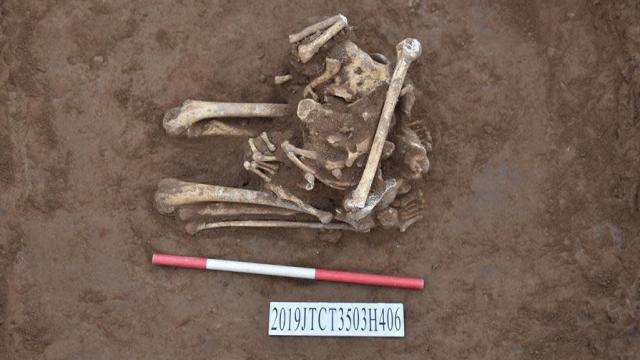Archaeologists in central China have unearthed a decapitated skeleton still resting in its final kneeling position. Such practices were hinted at in ancient Chinese scripts, but this discovery is further proof of this particular sacrificial rite.
The discovery was made at the Chaizhuang site in Jiyuan, located in China’s Henan province, reports Xinhua, the country’s largest state-run news agency. Archaeologists from the Henan Provincial Institute of Cultural Relics and Archaeology and the Jiyuan Municipal Cultural Relics Team have been digging through the site since 2019. To date, they’ve managed to comb through 6,000 square meters (64,600 square feet) at Chaizhuang.
The site dates back to the Shang Dynasty, which ruled from around 1600 BCE to 1046 BCE. The site has yielded evidence of houses, water wells, stoves, roads, and a surprising number of tombs. The archaeologists have also uncovered various relics, such as pottery, bones, jewellery, and even evidence of seafood and fireworks, according to Xinhua.
The team also uncovered a sacrificial pit with a decapitated victim still inside. The skeleton was found in its final kneeling position, its body facing north with arms folded in front. Looking very carefully at the photo, it even appears that the individual’s hands are still clasped together. Wow.
These grim remains are providing crucial evidence of the social and spiritual customs that were in place during this time period.
In particular, the skeleton affirms a suspected Shang Dynasty practice in which sacrificed individuals were buried in an upright position. Evidence found at a different site, the Yin Ruins, suggested as much—specifically, the discovery of oracle bone inscriptions with glyphs describing the practice.
Known in China as “Jiaguwen,” these scripts, or glyphs, represent some of the earliest fully developed characters in ancient China. Glyphs were often etched onto human and animal bones and even tortoise shells, reports Xinhua.
Importantly, a piece of oracle bone bearing the “Kan” glyph was found at the Chaizhuang site, a symbol associated with the sacrificing of people or livestock in pits, reports Xinhua.
“This well-preserved human bone is shaped like the oracle bone inscription of the character ‘Kan,’” explained Liang Fawei, leader of the Chaizhuang site excavation project, to Xinhua.
During the Shang Dynasty period, the scripts “She,” “Shi,” “Tan” and “Kan,” were used to denote sacrificial activities performed at different rituals, with Kan depicting burials in an upright position, Liang explained to Xinhua. The Kan glyph was somewhat of an oddity, given the prevailing archaeological evidence, as human sacrifices have primarily been found lying down.
[referenced url=” thumb=” title=” excerpt=”]
The recent discovery of the kneeling skeleton is further proof of this sacrificial practice, which may have been common, given the dedicated glyph. As always, however, more evidence in the form of similar burials and more oracle bones would help to strengthen this argument.
